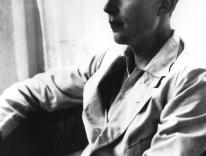In Italy a few weeks ago I had an afternoon to tour the Tuscan city of Siena. I spent almost all of it in the cathedral. Its overwhelming beauty held me captive.
Architecturally, the Duomo combines Gothic and Romanesque themes, including the hallmark black-and-white striped campanile, a square bell tower with pyramidal roof ornamentation. That zebra-striping -- black and white are the colors of the coat of arms of Siena -- continues in the cathedral’s gaudy interior with the marble columns of its towering nave arcades. The decorative ornateness of the place is mind-blowingly, excessively, even dizzyingly gorgeous, like a hallucination.
I craned my neck to take in the hexagonal dome with its trompe l’oeuil coffers, painted in blue with golden stars, far far above. Standing here you’re surrounded by a space so opulent, so stocked with artistic riches, you hardly know where to turn first. There is the altarpiece sculpture of St. Paul, by the young Michelangelo (who cast the face of Paul after his own likeness). Donatello’s bronze statue of St. John the Baptist is set in the eponymous cappella located in the left transept. Opposite, in the right transept, I spent half an hour sitting silently in the luminous Chapel of the Madonna del Voto, taking in the sculptures by Bernini and the painting of the Madonna supported by gilded bronze angels against a backdrop of brilliant blue lapis lazuli.
But the greatest treasure on offer in the cathedral is not overhead, nor surrounding you on all sides, but beneath your feet: 56 etched and inlaid marble panels that make up the cathedral’s floor. Most are kept covered during the year, except for a two-month period every fall. Timing is everything, and I lucked out.
The mosaics were designed between 1369 and 1547 by artists from Siena. Varying in size and shape – rectangular, hexagonal, even rhomboid -- they combine two techniques: graffito (holes and lines cut in the marble and then filled with black stucco) and intarsia (inlaid sections and pieces of black, white, green, red and blue marble). They reminded me of the lovely pietra dura works I’d admired in Florence years before, though on a far grander scale. You may feel like tiptoeing, because you’re walking on a marble carpet of ineffable glory.
For subjects the Siena artists drew on the Old Testament, Greek mythology, assorted allegories, and personages Biblical, historical and mythical. The earliest panel is The Wheel of Fortune, laid in 1372, showing four ancient philosophers - Epictetus, Aristotle, Seneca and Euripides – commenting on the vicissitudes of fortune and warning us against the seductive dangers of prosperity. The She-Wolf of Siena shows various animals, symbolizing confederated Italian cities, organized in a circle around the she-wolf, who is suckling Romulus and Remus (legend holds that Siena was founded by Remus’s son, Senius). Further up toward the apse, two sweeping 16th century works by Domenico Beccafumi show Moses shouldering the tablets on Mt. Sinai and striking water from the rock, as told in Exodus and Numbers.
But my favorite marble floor panel is one of the few by an artist not from Siena – the Umbrian painter Bernardino di Betto, better known as Pinturicchio (who also painted the majestic frescoes in the Piccolomini Library, adjoining the cathedral on the left side). Like The Wheel of Fortune, The Allegory of the Hill of Wisdom (1505) exhorts us to keep our gaze fixed metaphorically upward, toward higher fulfillments. It depicts a group of wise men debarking from a boat captained by the Roman goddess, Fortuna, to climb a mountain towards the goddess of wisdom Sapientia, who is flanked at the peak by Socrates and his contemporary Crates of Thebes. Socrates holds a book and is reaching out to receive a pen from Sapientia, while Crates, the Cynic who gave away all his worldly goods to live a life of penury, is busy dumping out a basket full of necklaces and other glittering jewelry. Together the two remind the sages, as they struggle up a precarious path littered with rocks and patrolled by serpents, that to attain the peak of wisdom they must cast aside the glittering temptations of wealth and worldly goods, and focus on knowledge alone.
It’s pleasurably paradoxical to receive philosophical and theological arguments for poverty amid such dazzling magnificence, and via works of art that are themselves literally priceless. Yes, throw aside all worldly riches – but don’t look up, down, or sideways! The immeasurable splendor of a cathedral like this duly apportions glory to God and God’s house, even as it lays bare a basic tension in the faith between the ecclesiastical and the Christological – right there in a glimmering palace that exists to transmit, and glorify, the humble spiritual exhortations of Jesus.
The cathedral abounds in Biblical motifs as well as art that exudes ecclesiastical deference (the horizontal moulding around the nave and the presbytery, for instance, contains 172 plaster busts of popes). But it is the prevalence of secular motifs, themes, myths and figures that fascinated me. Uniting hortatory humanistic themes with Biblical ones, the Duomo provides a textbook illustration of Renaissance humanism and its productive incorporation into Christianity. This is what makes a visit there both inspirational and instructional, in equal measure.
And, most of all, just plain amazing. A friend of mine in Manhattan, when I got back and told him about my visit to the cathedral, told me that he’d found himself thinking about the Siena Duomo on the day Pope Francis visited New York and stopped at St. Patrick’s. “We made such a big deal of it,” he said. “But I think Francis must have looked around and thought, ‘Jeez, they’re kind of chintzy here in the U.S.”
You can see additional images of the cathedral’s art and architecture here... and more of its marble inlay masterpieces here and here. Enjoy!


